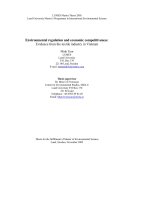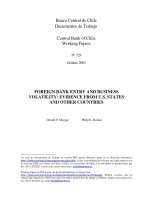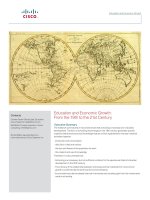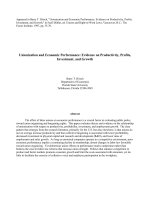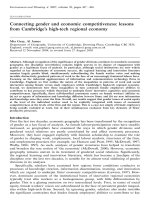inequality and economic growth evidence from argentina's provinces using spatial econometrics
Bạn đang xem bản rút gọn của tài liệu. Xem và tải ngay bản đầy đủ của tài liệu tại đây (2.43 MB, 274 trang )
INEQUALITY AND ECONOMIC GROWTH:
EVIDENCE FROM ARGENTINA’S PROVINCES USING SPATIAL
ECONOMETRICS
DISSERTATION
Presented in Partial Fulfillment of the Requirements for
The Degree Doctor of Philosophy in the Graduate
School of The Ohio State University
By
Alejandro A. Cañadas, M.B.A.
*****
The Ohio State University
2008
Dissertation Committee:
Approved by
Professor Claudio Gonzalez-Vega, Adviser
Professor Mark Partridge
Professor Joseph Kaboski
____________________________
Adviser
Graduate Program in Agricultural,
Environmental and Development Economics
3313008
Copyright 2008 by
Canadas, Alejandro A.
All rights reserved
2008
3313008
Copyright by
Alejandro Cañadas
2008
iii
ABSTRACT
This dissertation analyzes whether or not the spatial distribution of inequality in
the provinces of Argentina affects real per capita economic growth. The primary
objective is to decouple the effect of inequality into within inequality, which is the own
province i level of inequality, and the spillover of inequality from the closest provinces to
province i. Furthermore, another important objective is to decouple the influence of
inequality into long-run and short-run effect
To accomplish this, I based the analysis on a framework used by Partridge (2005),
which starts considering a very simple model, called a “parsimonious” model with a few
key variables. Building on that simple model I started adding a set of important control
variables in order to get a more fully specified model, called “base” model. The main
idea of using this methodology is that the “parsimonious” models, with only a few
variables (income distribution and a few other control variables), not only reduces
multicollinearity but also it is a test for robustness in the relationship between inequality
and growth (Perotti, 1996; Panizza, 2002; Partridge, 2005).
In addition, following Partridge (2005), I considered that income distribution
might have an entirely separate effect at the middle versus the tails of the distribution.
Therefore, I decided to include the Gini that controls for the overall distribution, and the
third Quantile share (Q3) that controls for middle-class consensus and the role of the
ii
median voter. The purpose of having two variables of income distribution is that when
the Q3 is included in the model, the Gini controls for the overall distribution, especially
at the tails, while Q3 controls for middle-class consensus and the role of the median
voter.
Additionally, a key difference from Partridge (2005) framework, apart from the
decoupled effect of inequality into within inequality, which is the own province i level of
inequality, and the spillover of inequality from the closest provinces to province i, is the
explicit consideration of possible spatial autocorrelation in the models. To achieve this, I
used two of the simplest spatial specifications: the spatial lag and spatial error models.
In the dissertation I have found very robust evidence that the own province i
inequality, and the inequality of the neighboring provinces of province i, affects
negatively the economics growth of the provinces of Argentina in the period 1991-2002.
Morerover, I have also found robust evidence that the third Quantile (Q3) affects
negatively the economics growth, which is not consistent to the vibrancy of the middle
class. The overall pattern of my results are not consistent with a long-run
classical/incentive interpretation but to a political economy interpretation, in which the
distortionary redistribution policies and social or political conflict are generated by the
difference in inequality among provinces.
.
iii
Dedicated to my beloved family, my lovely wife, Cynthia, my son Santiago, and my
daughter María Camila
iv
ACKNOWLEDGMENTS
This dissertation is the end product of a five-year journey that began when
I started working toward my Ph.D. at The Ohio State University. Many people have
walked (and stumbled) with me throughout these years. First and foremost, I would like
to thank my advisor Dr. Claudio Gonzalez-Vega. His encouragement and guidance have
been invaluable to go through some turbulent moments of the Ph.D. program, particularly
the first year. I also want to thank Don Claudio for giving me the opportunity to work as
his assistant since 2003. I learned a great deal from him and I will always remember him
as a smart thinker, generous person, and enthusiastic teacher.
I also want to thank Dr. Mark Partridge and Dr. Joe Kaboski, who played a
fundamental role in helping me develop this research. They were always ready to read
my draft, give me precious advice, and offer suggestions that help me to be ready for the
job market. Moreover, I am very grateful to Dr. Dave Kraybill and Dr. Ian Sheldon for
teaching the best classes I have ever had and inspiring the topics for this dissertation. I
am also very thankful to Stan Thompson, Fred Hitzhusen, Mario Miranda, and specially
my advisor from the PFF Program (Preparing Future Faculty) Dr. Robert Ebert, from
Baldwin Wallace College, for all his support.
I am very grateful to Ricardo Martinez ( ) from
the CEPAL office in Buenos Aires, who provided me with Argentina's provincial per
v
capita GDP and to Dr. Leonardo Gasparini from CEDLAS, Universidad Nacional de La
Plata, Argentina (), who offered me useful comments
in the manipulation of the survey from the EPH.
Working as a staff member at AEDE, I have had the pleasure to work with Joan
Weber and Susan Miller, who always have been very kind to me.
During these years, I shared wonderful moments with fantastic people that I want
to mention: Franz Gomez-Soto, Francisco Monge-Ariño, Erik Davidson, Mauricio
Ramirez, Maria Jose Roa, Carlos Alpizar, Jose Pablo Barquero, Malena Svarch, Paula
Cordero-Salas, Carolina Castilla, Emilio Hernandez, Scott Pearson, Carolina Prado, and
Marcelo Villafani.
I extend my love to my family, my dad, mom, Angeles and Marita, as well as my
friends, Hernan Bourbotte, Diego Sica, Octavio Groppa, Mariano Massano, Juan Pablo
Tiepolt, Jill Gerschutz, Ana Maria Gilmore, and William Hamant, and I thank them for
believing in me and for supporting my dreams from a distance.
Nothing would have been possible without my wife’s unconditional support, care
and love. She gives me the strength and courage to do things I would have never
imagined I could. I thank God for her and for our precious little son, Santiago, and our
daughter, María Camila, and for all God’s strength through all these years.
vi
VITA
March 13, 1972………Born – Jujuy, Argentina.
1995 – 1996…………..Economist, Arthur Andersen
1997…………………..B.S. (Licenciatura) Economics, Universidad Católica Argentina
1996 – 2000…………..Marketing Researcher, Telefónica de Argentina
2000 – 2003…………..Masters of Business Administration,
University of Dayton, Ohio
2004– 2008…………...Graduate Research Associate, Rural Finance Program,
Agricultural, Environmental and Development Economics,
The Ohio State University
vii
FIELDS OF STUDY
Major Field: Agricultural, Environmental and Development Economics
Minor Fields: Development Economics
viii
TABLE OF CONTENTS
Page
Abstract. ...................................................................................................................... ii
Dedication ................................................................................................................... iv
Acknowledgements...................................................................................................... v
Vita............................................................................................................................. vii
List of Tables ............................................................................................................ xiii
List of Figures ........................................................................................................... xvi
Chapters
1.
Introduction...................................................................................................... 1
1.1 Motivation............................................................................................... 1
1.2 Growth, Distribution and Poverty........................................................... 3
1.3 Spatial Dependence and Convergence.................................................... 6
1.4 Research Questions and Objectives ........................................................ 6
1.5 Research Strategy.................................................................................... 8
1.6 Hypotheses.............................................................................................. 9
1.7 Contents ................................................................................................ 11
1.8 Significance and Relation to the Present State of Knowledge.............. 11
1.9 The Influence of Inequality on Growth ................................................ 13
ix
2.
Argentina........................................................................................................ 18
2.1 Argentina, a Beautiful Country............................................................. 18
2.2 Initial Conditions .................................................................................. 19
2.3 Argentina as a Puzzling Country .......................................................... 23
2.4 What Went Wrong, and When? ............................................................ 26
2.5 Volatility of Growth.............................................................................. 27
2.6 The Argentinean Economy ................................................................... 30
2.7 The Argentinean Economy ................................................................... 32
2.8 A Caudillo Country............................................................................... 38
3.
Economic Growth in Argentina ..................................................................... 41
3.1 Per Capita Income in Latin America: A Long-Run Comparative
Perspectives................................................................................................. 43
3.1.1 Historical Per Capita GDP Estimates for Latin America............ 43
3.1.2 Income Convergence in Latin America ...................................... 46
3.2 Comparative Perspective ...................................................................... 47
3.3 The Data................................................................................................ 49
3.3.1 Changes in geographical coverage.............................................. 50
3.3.2 The New EPH Continua............................................................... 51
3.3.3 Limitations ................................................................................... 53
3.4 Convergence Concepts and Spatial Effects .......................................... 54
3.4.1 Spatial Effects in the Analysis of Regional Income Convergence56
3.4.2 Exploratory Spatial Data Analysis of Argentina’s Income
Convergence ......................................................................................... 57
3.5 Spatial Autocorrelation ......................................................................... 58
3.5.1 Local spatial autocorrelation....................................................... 62
3.6 Income Comparison among the Provinces of Argentina ...................... 66
x
4.
Inequality in Argentina .................................................................................. 68
4.1 Importance of the Study of Inequality .................................................. 69
4.2 Relationships among Poverty-GrowthInequality…………………………………………………………………..69
4.3 Relationship between Inequality and Growth....................................... 70
4.4 Inequality in Argentina ......................................................................... 73
4.5 Inequality in Latin America .................................................................. 76
4.6 Regional Inequality in Argentina.......................................................... 81
4.7 Spatial Autocorrelation of Income Inequality....................................... 82
4.7.1 Local Spatial Autocorrelation for Income Inequality ................. 84
5.
Empirical Implementation ............................................................................. 88
5.1 Spatial Econometrics ............................................................................ 88
5.1.1 The Problem of Spatial Autocorrelation ...................................... 89
5.1.2 Spatial Lag Operator .................................................................... 93
5.1.3 Spatial Autocorrelation in a Regression Model ........................... 94
5.2 Inequality-Economic Growth Models................................................... 98
5.3 Regression Specification..................................................................... 100
5.3.1 Spatial Econometric Model Specification .................................... 101
5.3.2 Spatial Lag Model......................................................................... 102
5.3.3 Spatial Error Model....................................................................... 103
5.4 Empirical Results ................................................................................ 104
5.4.1 Parsimonious Long Run Model ..................................................... 104
5.4.2 Base Long Run Model ................................................................... 109
5.4.3 Gini Spillover Effect Model........................................................... 116
5.4.4 Pooled-OLS Models....................................................................... 117
5.4.5 Instrumental Variables Model........................................................ 134
xi
5.4.5.1 Durbin-Wu-Hausman Tests for Endogeneity .................... 134
5.4.6 Spatial Pooled-OLS Models .......................................................... 137
5.4.7 Panel Data Models ......................................................................... 138
5.4.7.1 Fixed Effect Model ............................................................. 142
5.4.7.2 Random Effect Model......................................................... 144
6.
Conclusions.................................................................................................. 149
6.1 Summary ............................................................................................. 149
6.2 The Main Results ................................................................................ 150
6.3 Contributions....................................................................................... 154
6.4 Policy Implications ............................................................................. 157
6.5 Limitations and Future Research ........................................................ 157
Bibliography ............................................................................................................ 168
Appendices............................................................................................................... 185
Appendix A: Tables and Figures for Chapter 1 ........................................ 185
Appendix B: Maps from Argentina .......................................................... 192
Appendix C: Geary-Khamis method of aggregation ................................ 205
Appendix D: Tables and Figures for Chapter 3 ........................................ 214
Appendix E: Tables and Figures for Chapter 4 ........................................ 238
xii
LIST OF TABLES
Table
Page
2.1
Comparison of per capita GDP among developed countries, 1820-1990…25
2.2
Summary statistics for the annual rate of growth of per capita GDP for
Argentina, 1810-2004 (percentage) ........................................ ……………28
2.3
Comparison of GDP (PPP) and per capita GDP (PPP) for the seven largest Latin
American economies, in 2007..................................................................... 30
2.4
Comparison of labor force, unemployment rate, poverty and inequality for the
seven largest Latin American economies, in 2007 ................................... 31
A.1
Population living below the US$ 1 poverty line, 1990 and 2001 ............ 188
A.2
Population living below the US$ 2 poverty line, 1900 and 2001 ............. 189
A.3
Indicators of inequality for selected Latin American countries, the United
States, and Italy, late 1990s....................................................................... 190
D.1
Average per capita income growth rates for the seven major Latin American
economies, 1810-2004 .............................................................................. 215
D.2
Average annual rates of growth of per capita GDP for regions of the world,
1820-2004 (percentage). ........................................................................... 221
D.3
Economic Regions and Provinces in Argentina. EPH .............................. 223
D.4
Urban Conglomerates by Provinces in Argentina..................................... 224
xiii
D.5
Moran’s I statistics for the provincial per capita GDP of Argentina, 19802002………………................................................................................... 228
D.6
Summary of local Moran statistic as a measure of spatial association: real per
capita GDP by quadrants, 1980-2002 ....................................................... 232
E.1
Distribution of household per capita income in Argentina (deciles shares and
income ratios), 1992-2005 ........................................................................ 240
E.2
Inequality Indices from household surveys in major provincial cities in
Argentina, 1992-2005 ............................................................................... 241
E.3
Inequality in Latin America between 1950 and 2000. Measured by Gini
coefficients................................................................................................ 243
E.4
Changes in inequality measured by percentage points of Gini Coefficient using
household surveys in each country ........................................................... 244
E.5
Bonferroni and the Tukey’s tests to determine means differ in Gini coefficient
among regions in Argentina, 1991-2002 .................................................. 247
E.6
Changes in Gini coefficient, third quantile (Q3), top 10 percent and bottom 20
percent shares in income of the population by region, between 1991 and 2002
(percentage)............................................................................................... 248
E.7
Estimates of the Moran’s I statistic for the provincial Gini coefficients of
Argentina, 1991-2002 ............................................................................... 250
5.1
Results from parsimonious long-run models ............................................ 108
5.2
Base Long-Run Models ............................................................................ 115
xiv
5.3
Growth Model with Gini Spillover Effects............................................... 117
5.4
Pooled-OLS Models.................................................................................. 126
5.5
Robust, Clusters, FGLS, IV, and GMM Models ...................................... 133
5.6
Spatial autocorrelation test statistic for the spatial lag and error models . 140
5.7
Descriptive Statistics of the Panel Data Variables.................................... 139
5.8
Panel Data Models of Real Per Capita Growth ........................................ 147
5.9
Fixed Effect and Random Effect Models of Real Per Capita Growth ....... 148
xv
LIST OF FIGURES
Figure
2.1
Page
Map of the Republic of Argentina, its main cities, and neighboring countries
........................................................................................................... …… 21
2.2
Comparison of per capita GDP relative to the US for Argentina, Brazil and
Mexico, 1820-1990 ........................................................................... …… 24
2.3
Annual rate of growth of per capita GDP for Argentina, 1810-2004 (percentage)
........................................................................................................... …… 27
2.4
Coefficient of variation of the log of inter-annual per capita GDP for each
decade in Argentina, 1810-2004 ....................................................... …… 29
A.1
Gini coefficient for the income distribution in Latin America, 1950-2000 186
A.2
Poverty rates in Latin America, 1950-2000 ................................... …… 187
A.3
Trends in inequality in major Latin American countries from the early 1980s to
mid-2000s (Gini coefficients). ................................................................. 191
B.1
Satelital map of Argentina using Google Earth ........................................ 193
B.2
Satelital map of Argentina in South America using Google Earth........... 194
B.3
Satelital map of the provinces of Argentina using Google Earth ............. 195
B.4
Map of the provinces of Argentina ........................................................... 196
B.5
Map of the regions of Argentina............................................................... 197
B.6
Per capita income growth by province (1992-2002) using STATA ......... 198
xvi
B.7
Gini Coefficient by province in 1991 using STATA................................ 199
B.8
Gini Coefficient by province in 2002 using STATA................................ 200
B.9
Area of provinces in Argentina using STATA ......................................... 201
B.10
Density of population in the provinces of Argentina using STATA........ 202
B.11
Two main clusters for the real per capita income in the provinces of Argentina
using the Moran I, 1980-2002.................................................................. 203
B.12
Two main clusters for the Gini in the provinces of Argentina using the Moran I,
1991-2002 ................................................................................................ 204
D.1
Per Capita GDP for seven major Latin America economies, 1900-2004 216
D.2
Per Capita GDP for Argentina, 1810-2004............................................. 217
D.3
Average annual GDP growth rates experienced by the seven largest Latin
American economies between 1900 and 2004, with their corresponding (logged)
initial per capita income level in 1900..................................................... 218
D.4
Cross-country standard deviation of per capita GDP for the seven largest Latin
America economies, 1900-2004 .............................................................. 219
D.5
Coefficient of variation of log of per capita GDP for the seven largest Latin
America economies, 1900-2004 .............................................................. 220
D.6
Per capita GDP for the United States, United Kingdom, Germany, Norway,
Australia, Japan and Argentina, 1820-2004............................................. 222
xvii
D.7
Average annual GDP growth rates experienced by 23 provinces of Argentina,
1980-2002, with their corresponding (logged) initial per capita income level in
1980.......................................................................................................... 225
D.8
Coefficient of variation of the log of provincial real per capita GDP for 23
provinces and the capital city (Ciudad Autónoma de Buenos Aires) in
Argentina, 1980-2002 ............................................................................. 226
D.9
Moran's I statistic for the provincial real per capita GDP of Argentina, 1980-2002
................................................................................................................... 227
D.10
Provincial coefficient of variation of the log of provincial real per capita GDP
for 23 provinces and the capital city of variation and the Moran's I statistic,
Argentina, 1980-2002 ............................................................................... 229
D.11
Local Moran’s I statistic for the provincial real per capita GDP in 1980. 230
D.12
Local Moran’s I statistic for the provincial real per capita GDP in 2002. 231
D.13
GDP participation of the five richest provinces in Argentina, 1980, 1991 and
2002........................................................................................................... 234
D.14
Population participation among the five largest regions........................... 235
D.15
Population shares of the five largest provinces in Argentina, 1980, 1991 and
2002........................................................................................................... 236
D.16
Comparison of provincial per capita income relative to the country’s average,
for 1980, 1991 and 2002 ........................................................................... 237
xviii
E.1
Decomposition of a change in distribution and poverty into growth and
distributional effects.................................................................................. 239
E.2
Gini Coefficient for Argentina, from the distribution of per capita household
income, 1992-2005 ................................................................................... 242
E.3
Provincial Gini coefficients for Argentina. Averages for 1991-2002....... 245
E.4
Regional Inequality in Argentina, as shown by Gini coefficients. Averages for
1991-2002 ................................................................................................. 246
E.5
Moran’s I statistic for the provincial Gini coefficients of Argentina, 1980-2002
................................................................................................................... 249
E.6
Local Moran’s I statistic for the Gini coefficients provincial in 1991...... 251
E.7
Local Moran’s I statistic for the Gini coefficients in 2002....................... 252
E.8
Local Moran’s I statistic for the Gini coefficients in 2001....................... 253
xix
CHAPTER 1
INTRODUCTION
1.1 Motivation
This dissertation is about the effects of the inequality in the income distribution
on per capita GDP growth in the provinces of Argentina.
A recent report of the World Bank claims that the levels of inequality in Latin
America are well above those of developed countries. The Gini coefficient for the region
is about 0.55, compared to 0.37 for developed countries (de Ferranti et al., 2004). The
report also indicates that, together with Sub-Saharan Africa, Latin America has long been
known as the region with the highest inequality in the world, with a Gini coefficient
above 0.50 since the 1960s, as shown in Figure 1 in Appendix A. While inequality in
Argentina has been below the region’s average, it has been increasing over time.
The fact that the first of the Millennium Development Goals is to “eradicate
extreme hunger and poverty by 2015” shows that poverty is perceived as one of the most
important problems in the world. Both poverty and persistent inequality are major
challenges in Latin America.
Tables 1 and 2 in Appendix A show that, by 2001, some 128 million people in
Latin America lived below the US$2-a-day poverty line. Of those, 10 million lived below
1
the US$1-a-day poverty line. Nevertheless, if we look at the incidence of poverty in Latin
America and the Caribbean, as a share of the total population, the region’s poverty levels
are among the lowest, well below those for East Asia, South Asia, and Sub-Saharan
Africa. In contrast to those regions, poverty in Latin America is less a rural and more an
urban phenomenon.
In the long term, the region has experienced important gains in alleviating
poverty. Figure 2, in Appendix A, shows that, while measured using a poverty line of
US$ 2 per person a day, in Latin America the incidence of poverty declined rapidly
between 1950 and 1980, but this process slowed down and the poverty rate was still
above 20 percent by 2000.
Despite this progress, the problem continues to be acute. According to estimations
of the Economic Commission for Latin America and the Caribbean for 2006, 71 million
persons (13.4 percent of the total population of Latin America) were extremely poor,
while the number of poor people (including those 71 million) was estimated at 194
million, equivalent to 36.5 percent of the region’s population (ECLAC, 2007).
According to some authors, in Latin America the problems of poverty and
inequality have been related to weak economic growth (Perry et al., 2006). Inequality, in
turn, may have also influenced economic growth itself. Thus, inequality matters per se
and because of its association with other critical outcomes, such as poverty and a
country’s growth performance.
Both within the region and in comparison to other regions, inequality varies a lot.
In most Latin American countries, the richest 10 percent of the individuals earned
between 40 and 47 percent of total income, while the poorest 20 percent received only
2
between 2 to 4 percent (Table 3 in Appendix A). In contrast, the richest 10 percent in the
United States received 31 percent of total income while, in Italy, individuals in this decile
earned 27 percent. Even the most egalitarian countries in Latin America (Costa Rica and
Uruguay) show comparatively high levels of income inequality. This concentration has
been substantially higher than in OECD countries, Eastern Europe, and most of Asia.
Only some countries in Africa and the successor states of the former Soviet Union show
comparable inequality (de Ferranti et al., 2004). Moreover, when inequality is measured
as the shares of the richest and the poorest quintiles, Latin America is the least equitable
region in the world.
In Argentina, inequality has dramatically increased since 1950. The Gini
coefficient for the household per capita income distribution in the urban areas increased
from 0.421 in 1992 to 0.535 in 2003 (CEDLAS, 2003). Even if observations for the
recent years of economic crisis are ignored, the trend toward increased inequality is
evident. This trend has steadily reduced the difference between Argentina and other
major countries with more concentrated distributions in Latin America (Figure 3 in
Appendix A). No other Latin American country has experienced such deep distributional
changes as Argentina (Gasparini and Sosa Escudero, 2001). This dissertation addresses
the consequences of this inequality in distribution on regional economic growth.
1.2 Growth, Distribution and Poverty
The performance of an economy is usually described in terms of mean variables,
such as per capita GDP or disposable income. If per capita GDP increases, namely, if
“the economy grows,” performance is considered to be positive. While important, this
3
evaluation is incomplete, because it does not consider the distribution of income.
Actually, an increase in mean income can reflect different combinations of poverty and
distributional changes. However, the linkages among growth, poverty, and income
distribution are complex (Ferreira, 1998). Some authors (Ravallion, 2001; Besley and
Burgess, 2003) illustrate the relationships between poverty, income growth, and
inequality by providing examples of how both growth and changes in inequality influence
poverty.
A widespread concern for pro-poor growth has resulted in part from evidence
showing that, in some countries, the fruits of economic growth have not been equally
shared by the population and from evidence that during some growth events the wellbeing of the poor actually decreased (Perry et al., 2006). The relationship is even more
relevant if an economy experiences negative growth, when poverty deepens further. In
Latin America, growth and poverty patterns have differed substantially across countries
and within countries over time. There are cases of sustained growth and poverty
reduction, like Chile, along with unfavorable experiences in terms of poverty, such as
Argentina and Venezuela.
This mix of experiences makes the analysis of pro-poor growth particularly rich.
Moreover, the issue has been at the core of political debates. Recent episodes of
economic growth combined with unchanged or even increasing poverty have made some
people question the proposition that growth is strongly linked to poverty reduction.
Others have been concerned about the ways in which initial poverty influence growth and
have explored the persistence of poverty traps (Azariadis, 1996a, 1996b). This
4
